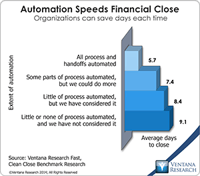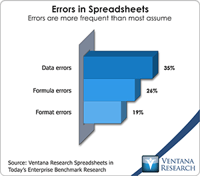Tagetik provides financial performance management software. One particularly useful aspect of its suite is the Collaborative Disclosure Management (CDM). CDM addresses an important need in finance departments, which routinely generate highly formatted documents that combine words and numbers. Often these documents are assembled by contributors outside of the finance department; human resources, facilities, legal and corporate groups are the most common. The data used in these reports almost...
Read More
Topics:
Big Data,
Mobile,
ERP,
Human Capital Management,
Modeling,
Office of Finance,
Reporting,
Budgeting,
close,
closing,
Consolidation,
Controller,
Finance Financial Applications Financial Close,
IFRS,
XBRL,
Analytics,
Business Analytics,
Business Intelligence,
Governance, Risk & Compliance (GRC),
Business Performance Management (BPM),
CFO,
compliance,
Data,
Financial Performance Management (FPM),
benchmark,
Financial Performance Management,
financial reporting,
FPM,
GAAP,
Integrated Business Planning,
Profitability,
SEC Software
Oracle continues to enrich the capabilities of its Hyperion suite of applications that support the finance function, but I wonder if that will be enough to sustain its market share and new generation of expectations. At the recent Oracle OpenWorld these new features were on display, and spokespeople described how the company will be transitioning its software to cloud deployment. Our 2013 Financial Performance Management Value (FPM) Index rates Oracle Hyperion a Warm vendor in my analysis,...
Read More
Topics:
Big Data,
Mobile,
Planning,
Social Media,
ERP,
Human Capital Management,
Modeling,
Office of Finance,
Reporting,
Budgeting,
close,
closing,
Consolidation,
Controller,
driver-based,
Finance Financial Applications Financial Close,
Hyperion,
IFRS,
Tax,
XBRL,
Analytics,
Business Analytics,
Business Intelligence,
CIO,
Cloud Computing,
In-memory,
Oracle,
Business Performance Management (BPM),
CFO,
compliance,
Data,
Financial Performance Management (FPM),
benchmark,
Financial Performance Management,
financial reporting,
FPM,
GAAP,
Integrated Business Planning,
Price Optimization,
Profitability,
SEC Software
Because of its impact on the Office of Finance, I’ve written in the past about the proposed timeline and IT implications of the convergence of U.S. Generally Accepted Accounting Principles (U.S. GAAP) and the International Financial Reporting Standards (IFRS). While the bottom-line differences between U.S. GAAP and IFRS are likely to be minimal for most businesses, some aspects of the convergence promise to be significant and problematic. One important change is how companies account for...
Read More
Topics:
GRC,
Office of Finance,
control,
error,
IFRS,
Governance, Risk & Compliance (GRC),
Business Performance Management (BPM),
CFO,
Financial Performance Management (FPM),
Financial Performance Management,
GAAP
Many people enjoy mystery stories or crime thrillers; in the same vein of savoring the whodunnit and howdunnit, I like a good accounting scandal. My fascination with cooking the books started when I was young with the “great salad oil swindle”, which wound up causing losses in excess of $1 billion in today’s money and even threatened a Wall Street collapse. This disaster was averted by the assassination of President Kennedy, which kept markets closed on Monday, November 25, 1963, and gave the...
Read More
Topics:
Fraud,
Governance,
GRC,
Office of Finance,
audit,
IFRS,
Governance, Risk & Compliance (GRC),
Business Performance Management (BPM),
Financial Performance Management (FPM),
Hewlett Packard,
Meg Whitman,
SEC
I have commented before on the movement to adopt International Financial Reporting Standards (IFRS) by the United States to replace US-GAAP (Generally Accepted Accounting Principles). Most recently I discussed the drive to harmonize the significant differences between US-GAAP and IFRS on revenue recognition and lease accounting. To those who are interested in but not intimately involved with the subject, I suspect the current situation is a bit confusing, since there are multiple groups...
Read More
Topics:
Reporting,
audit,
Consolidation,
IFRS,
US-GAAP accounting,
XBRL,
Business Analytics,
Business Collaboration,
Business Performance Management (BPM),
Financial Management,
Financial Performance Management (FPM),
financial standards,
FPM
I recently attended Vision 2012, IBM’s conference for users of its financial governance, risk management and performance optimization software. From my perspective, two points are particularly worth noting with respect to the finance portion of the program. First, IBM has assembled a financial performance management suite capable of supporting core finance processes as well as more innovative ones. It continues to build out the scope of this suite’s capabilities to enhance ease of use, deepen...
Read More
Topics:
Performance Management,
close,
closing,
IFRS,
Analytics,
IBM,
Uncategorized,
GAAP
JDA Software is an established vendor of (among other categories) accounting software for the retail sector. So it is a bit ironic that the company is in the process of restating its earnings for 2008 through 2010 because of revenue recognition practices that led it to book some revenue sooner than it should have. The issue centers on certain transactions the company linked to service agreements and license revenue. As well, in 2009 and 2010 some of its license contracts included a clause...
Read More
Topics:
Performance Management,
Customer Experience,
Human Capital Management,
Office of Finance,
end-to-end,
IFRS,
JDA Software,
Business Analytics,
Governance, Risk & Compliance (GRC),
Financial Performance Management (FPM),
GAAP
Read More
Topics:
Office of Finance,
closing,
Controller,
FASB,
IASB,
IFRS,
XBRL,
Analytics,
Business Analytics,
Business Intelligence,
Financial Performance,
Governance, Risk & Compliance (GRC),
Business Performance Management (BPM),
CFO,
Financial Performance Management (FPM),
financial statement,
GAAP,
SEC
For me, the most significant announcement to come out of the recent SAPinsider conference was the company’s formal release of Business Planning and Consolidation (BPC) running on HANA, SAP’s in-memory computing appliance. For me, HANA is a potential “game changer” for planning, statutory consolidation and other analytics-supported financial processes because of the substantial reduction it enables in processing time from loading to reporting. In-memory systems provide a substantial edge in...
Read More
Topics:
Big Data,
Mobile,
Planning,
SAP,
Social Media,
Customer Experience,
ERP,
GRC,
Office of Finance,
Operational Performance Management (OPM),
Budgeting,
IFRS,
XBRL,
Analytics,
Business Analytics,
Business Collaboration,
Business Mobility,
Cloud Computing,
In-memory,
Business Performance Management (BPM),
finance,
Financial Performance Management (FPM),
Sales Performance Management (SPM),
Supply Chain Performance Management (SCPM),
Workforce Performance Management (WPM),
Financial Performance Management,
GAAP,
HANA
The melding of the world’s two main financial accounting standards – United States Generally Accepted Accounting Standards (US-GAAP) and International Financial Reporting Standards (IFRS) – continues apace. Initially, the idea was to converge the two into a single, global standard. Although there was general agreement that the concept was a noble one, there were enough differences to produce practical concerns about implementing these changes, especially in the United States. Then, in December...
Read More
Topics:
Office of Finance,
Controller,
FASB,
IASB,
IFRS,
XBRL,
CFO,
Financial Performance Management (FPM),
financial statement,
GAAP,
SEC














